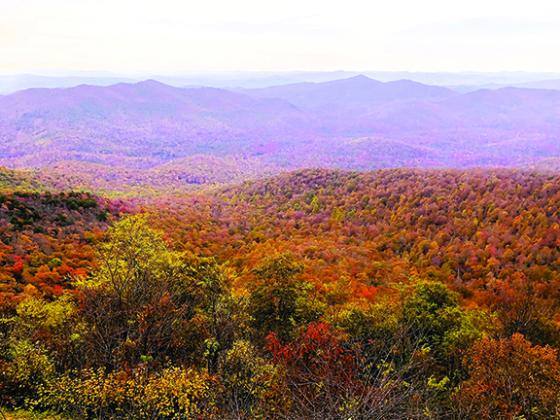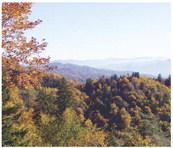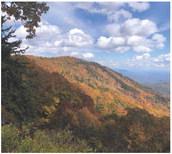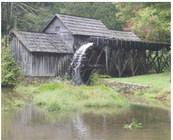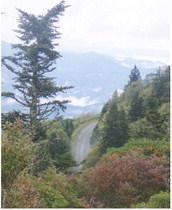by LeMoyne Mercer
ONE OF OUR FAVORITE TRIPS for fall color is two weeks or so through three national parks—Shenandoah, Blue Ridge Parkway, and Great Smoky Mountains. It is about 500 miles to Front Royal, VA and the beginning of 105-mile Skyline Drive in Shenandoah National Park. Skyline connects directly with the 469-mile Blue Ridge Parkway that, in turn, connects with the entrance to the Smokies in Cherokee, NC where Newfound Gap Rd. crosses through the park.
In addition to the usual objectives of preserving scenic attractions and wildlife, the parks strive to preserve our history and cultural heritage in the form of representative pioneer cabins, farm buildings, mills, churches, and cemeteries. The cemeteries, by the way, are still used for the burial of descendants of former residents. Headstones can tell fascinating stories. During the fall leaf-peeper season and the spring blossom season, a high percentage of visitors to all three parks are locals who have the option to take short excursions, heading north or south as far as they choose. Shirley and I stopped to see our friends Sandy and Bill who stayed in the family cabin at Galax, VA. They were known to drive the whole 15 miles down to Sparta, NC just to see the color along the way.
The color season along the Blue Ridge begins in late September and reaches its peak in the second half of October. The timing varies with the latitude and the elevation because fall arrives earlier in the north and at higher elevations.
Shenandoah
The Dickey Ridge Visitor Center, about four miles inside the park, has the usual displays, maps, brochures, and short park movie. There are splendid views of the Shenandoah Valley and beyond it rank upon rank of the Alleghenies marching westward until land and sky become indistinguishable. The park lodges at Skyland and Big Meadows offer comfortable places to view the farms and small towns in the Valley, have supper, and await the splendor of sunset.
There are other things to do in the park besides admire the color. Hike up to Stony Man Summit or Hawksbill for panoramic views. Watch for a string of hawks riding thermals, barely moving their wings on their migration south. If you are strong and agile, consider the Bearfence Rock Scramble. There is no trail in the traditional sense. You need both hands to help pull yourself up the 275 feet with blue blazes on the rocks to mark the route where you are less likely to get into serious trouble. Or hike down to Dark Hollow Falls or Lewis Falls. All the waterfalls are downhill because the trails start from Skyline Drive along the top of the ridge. The Appalachian Trail that runs 2,198 miles from Springer Mountain, GA to Mt. Katahdin, ME is easy to access in all three parks. Pick any short stretch just so you can brag you “hiked the AT.” Or take a twilight stroll through Big Meadows just as the deer are coming out to play.
Consider a ranger tour to President Hoover’s private fishing camp on the Rapidan River. Three buildings are left where Hoover took working holidays and entertained government officials and foreign dignitaries. Think of it as the first Camp David. Shirley and I have caught colorful native brook trout where Hoover did, right outside his door.
Blue Ridge Parkway
With 15.7 million visitors in 2022, Blue Ridge Parkway competes annually with the Smokies for the title of most visited national park. It is 469 miles long but so narrow that you can usually see far beyond the park boundaries to your right and left. In some places, the park is only a few feet wider than the road.
At Rockfish Gap, you leave Shenandoah, cross I-66, and immediately begin the Parkway. At Humpback Rocks Visitor Center is the Mountain Farm Museum with log cabin and outbuildings. This was the William Carter farm in the late 1800s when he bought it for $3 an acre—in Confederate money that had exactly the same value as the Monopoly kind.
Wigwam Falls, near MP 35, is just a few yards off the Parkway, across an old narrow-gauge rail line that parallels the road. This is by far the easiest to reach waterfall anywhere on the Blue Ridge, though Glassmine Falls may be visible in the distance from a pullout. It spills over a sheer 800-ft. rock wall and glistens brightly in the afternoon sun—except during dry periods when there is no water. Linville Falls, the most visited on the Parkway, is a double cascade that is reached by three trails—easy, moderate, and strenuous—that lead to five viewpoints.
Mabry Mill is the most photographed place on the Parkway. Sometimes the miller is on duty to demonstrate the grinding of cornmeal or wheat flour. Shirley and I stay at nearby Rocky Knob Campground so we can have a good ol’ downhome breakfast or lunch in the restaurant.
The Blue Ridge Music Center has a museum that will help you understand why mountain music is most definitely not country music. There is an auditorium for scheduled performances and impromptu jam sessions. The high level of musicianship, even among the amateurs, is surprisingly enjoyable even for people who think they would not like mountain music.
Moses Cone Memorial Park features his Flat Top Manor where the first floor is the Park Craft Center. There are often artists and craftsmen who will chat with you while they work. Cone built Flat Top as a 20room summer home for his family. It looks out over Bass Lake and his orchard of 32,000 prize-winning apple trees that went to markets as far as Europe.
The Folk Art Center has exhibits, demonstrations, and a store that sells exceptionally high-quality mountain arts and crafts. Prices reflect the quality. Just a few miles south in Asheville, NC is the Biltmore Estate, the magnificent 255-room French Renaissance Chateau that George Washington Vanderbilt created as his version of a “summer cottage.”
The Parkway passes through the Cherokee Indian Reservation and connects directly with Newfound Gap Rd. in the park. There is no entrance fee for the Smokies. The park is so popular that it can be difficult or impossible to find a parking spot, so since March of this year, the park has required a parking pass that costs $5/day, $15/week, or $40/year.
The Oconaluftee Visitor Center features another Mountain Farm Museum with log cabin, barn, outbuildings, vegetable garden, and farm animals. There are now numerous elk in the meadow, along the bordering river, and right in the road. On weekends in October, there may be craftsmen of various kinds, demonstrating how things used to be done. Across the road is the picturesque Mingus Mill where a miller is usually on site. When he is not grinding cornmeal, he is probably just strumming his banjo and chatting with visitors.
The road climbs to Newfound Gap where there are dramatic views. As you approach the Gap, a spur road goes left for seven miles up to Clingmans Dome, the highest point in the park at 6,643 ft. There is a paved trail that ascends for ½ mile to a lookout tower for a spectacular 360-degree panorama. The trail is paved but much too steep for wheelchairs and even for some pedestrians. Consider going up there only if it is a clear day. The peak may be wrapped in clouds with zero visibility.
The Gap itself, the dividing line between North Carolina and Tennessee, is right around the curve past the Clingmans Dome road. Last year there were long waits to get in the parking lot. There are more overlooks just down from the Gap that are almost as good. Almost. Four of the 14 Quiet Walkways (short nature trails) in the park are along Newfound Gap Rd.
Newfound Gap Road ends at Sugarlands Visitor Center, the Gatlinburg entrance to the park. Little River Road heads west from there until it morphs into the Laurel Creek Road at the Townsend road junction. The narrow road is a continuous series of sharp curves with a tumbling mountain stream a few feet to the right and a sheer rock wall to the left. It is a simply gorgeous drive. Along the way is the 2.6-mile paved trail to Laurel Falls and the pullout for The Sinks where there are cascades and a waterfall.
The road ends at Cades Cove, a picturesque mountain valley that is our favorite place in the Smokies. There is an 11-mile, one-way loop road around the perimeter. Its amazing natural beauty is supplemented by a historical experience that includes six pioneer log cabins with barns and outbuildings, three churches, and the Cable Mill. The Elijah Oliver place requires an easy walk of about half a mile, but all the others are right along the road. Start early when there is a better chance to see bears, deer, and wild turkeys. There is a long lineup well before the Loop Road opens at 8:00 a.m.
At the far end of the loop is the trail out to Abrams Falls, five miles total, out and back. It is generally fairly easy except for a short climb over a low ridge. The trail follows Abrams Creek and can be rocky and/or muddy, so don’t wear your party shoes. Or flip-flops.
When we first visited the Smokies in 1975, we went through Knoxville and then Sevierville and Pigeon Forge to Gatlinburg, the tourist destination right at the park entrance. The entire stretch from I-81 has since acquired motels, restaurants, tour companies, cable car rides, zip lines, helicopter tour offices, and gift shops standing shoulder to shoulder. Dolly Parton’s Dollywood theme park in Pigeon Forge attracts about three million visitors a year. Some people look forward to commercial attractions. Shirley and I tend to avoid them. You, of course, are entitled to the experience you prefer. Either way, you will find it just a walk in the park.
LeMoyne Mercer is the travel editor for Healthy Living News. You might like to see more of his stories and photos at AnotherWalkinthePark.blogspot.com.

